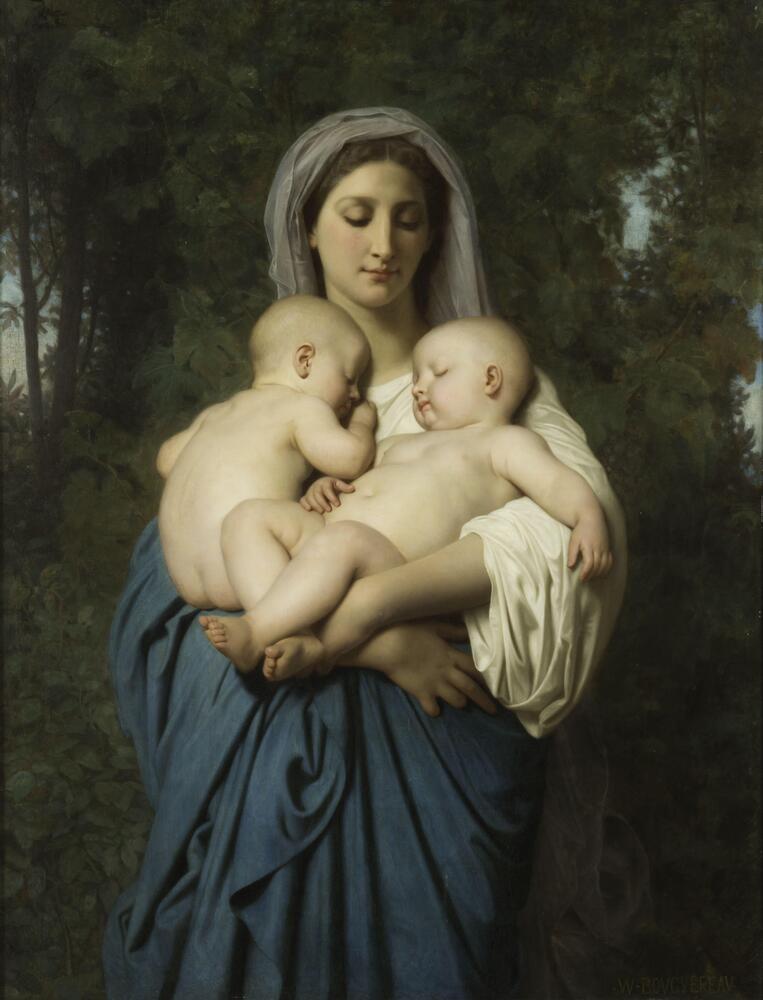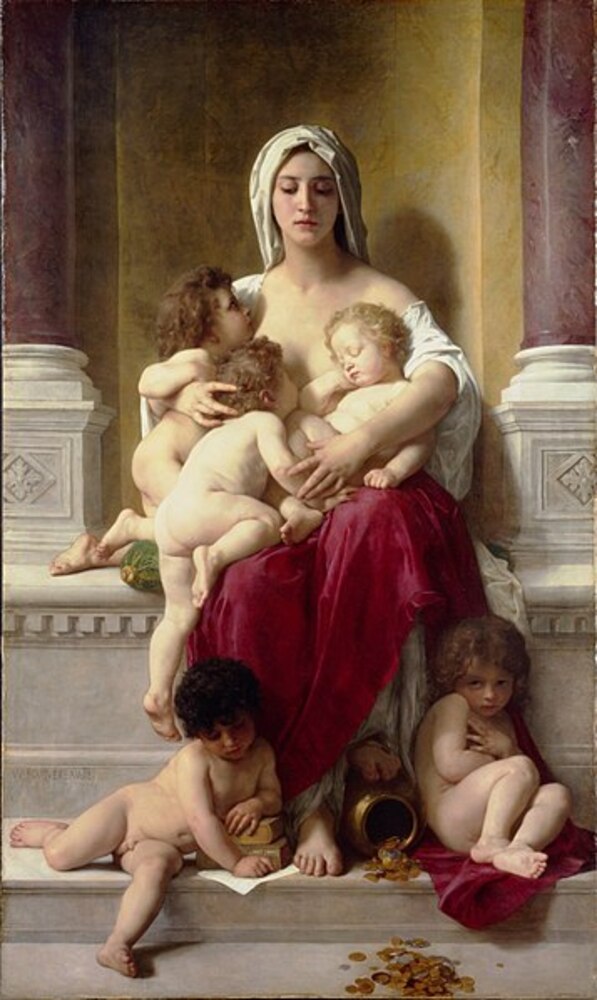Essay: Bouguereau
William Adolphe Bouguereau was considered the quintessential academic painter: he was favored by the powerful Paris Salon, painted biblical and mythological figures and practiced a regimented, Renaissance style of painting. Bouguereau was a compositionally brilliant painter who possessed a veritable talent at capturing lifelike forms. However, he lived and worked at the same time as Impressionist artists like Edgar Degas, Claude Monet, and James Whistler who rejected the prevalent academic style. He remained true to his classical training and worked diligently to produce pieces that were compositionally sound, richly pigmented, and featured classical subject matter.
William-Adolphe Bouguereau was born in La Rochelle, France in 1824. As a young teenager, he demonstrated an innate talent for painting, which he cultivated at the École de Beaux Arts. Bouguereau first studied with Francois-Eduoard Picot in Paris before his acceptance to the École des Beaux Arts. It was there that he learned classical modeling of form and traditional points of technique. In 1850 he won the coveted Prix de Rome, and awarded an all-expenses-paid trip to Rome, to study Italian Renaissance masters and antiquities. On his return to France, Bouguereau was accepted at the salon and was an elite member.
Academic painting during the nineteenth century was taught in art schools across Europe, employing traditional yet rigorous methods for an aesthetically pleasing and refined product. A true Academician, Bouguereau painted in stages. He would begin with a thumbnail scribble or a quick sketch that outlined the major compositional elements, then a figure drawing of models. He completed oil studies for individual body parts before moving on to the canvas. The last step was a full-sized cartoon (an outline in lead) and then the oil painting itself.
Bouguereau painted from life but took liberties with the subject matter. His paintings frequently featured historical, classical, and mythological figures. He labored intensely over the details of his figures until they seemed to jump off the canvas in a hyperreal style. Bouguereau’s figures appeared so real that it was hard to believe the work was created by a man.
The secular mother and child motif was a relatively new concept in art during the eighteenth and nineteenth centuries. The notion that a mother could have a special bond with her infant was promulgated in the eighteenth century, and Bouguereau handles the tender subject with deserved gracefulness. He returned to this motif several times over his career.
Bouguereau’s hyperreal style is starkly apparent in La Charité: the mother and children’s skin is unearthly. The figures in his painting are sculptural: the drapery of the woman’s cloak and the bodies of the children appear as if they had been carved out of marble by the skillful hands of an Italian sculptor, and the surface of the canvas has been carefully finished to eliminate any sign of brush strokes.
Bouguereau’s composition is directly derived from Renaissance models, Raphael was a favorite of his. The arrangement of the figures in a triangular shape, with the woman at the apex and the two children flanking either side of her is a common compositional style that highlights the balanced hierarchy of the figures. The audience’s eye is drawn in by the ascending diagonal lines and naturally follows upward to the meeting of the three heads. Against the dark, simple background, the bright faces of the three figures pop, asserting their prominence in the scene.
Bouguerau’s work reflected the period’s obsession with the past. He historicized the values of his time. Through the lens of classicism, Bouguereau commented and critiqued his own society, something few painters were doing at that time. It is important to note that he was an Academic working during a revolutionary time. This work was donated by Henry Clay Lewis, himself a conservative art collector. His conventional work became, at least in the eyes of Edgar Degas, a style in and of itself and the latter coined the term “Bouguerauté” (“Bouguereau-ized”) to describe conformist academic pieces. These attitudes have prevented Bouguereau’s work from maintaining the status it once held during his lifetime.
Discussion Questions
Bouguereau’s contemporaries chastised him for remaining true to the Academic style. How did hyperreality push the boundaries of art and relegate him to the past?
Why might it be important for artists like Bouguereau to play the role of “historian”?
Sources
Wissman, Fronia E. Bouguereau. San Francisco: Pomegranate Artbooks, c. 1996.
Further Reading:
"La Charité: Lot Essay." Christie's. Accessed February 1, 2018. http://www.christies.com/lotfinder/Lot/william-bouguereau-french-1825-1905-la-charite-1772365-details.aspx
Jane Braun (2008)
Eva Caston (2018)
Created For
K-12 EducatorK-12 Student
Museum Visitor
UMMA Docent
UMMA Staff
University Faculty
University Student
Rate this Resource
AVG: 0 | Ratings: 0
& Author Notes
Creative Commons by-nc-saLast Updated
April 30, 2018 7:37 p.m.Report
Reporting Policy


